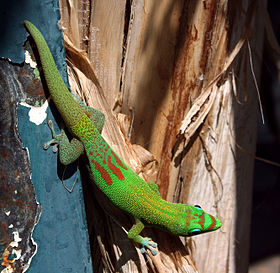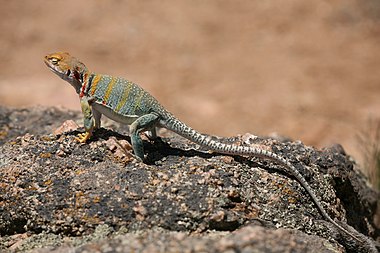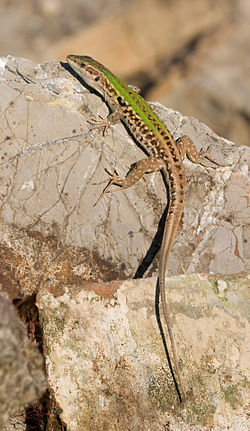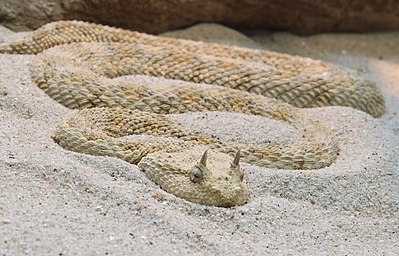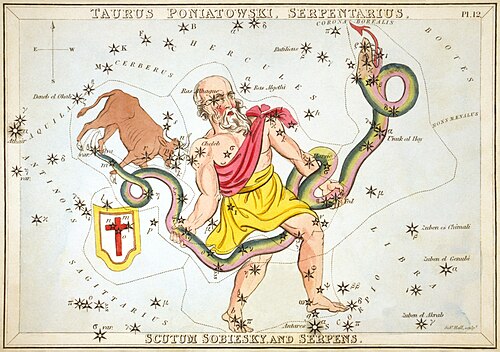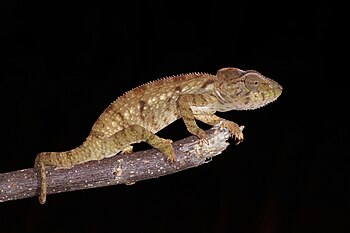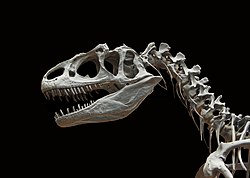Source: Wikipedia, the free encyclopedia.
Documentation
The Selected picture box on the portal chooses one of the following at random when displaying the page. Follow the instructions below for adding or nominating a new picture to the list.
Picture candidates
Feel free to add related featured pictures to the list. Nominate other pictures on the portal talk page.
- Pictures must be
- Free to use and hosted on
Commons
- Of good quality (not blurred, grainy or discoloured)
- Interesting
- Relevant to an article or topic
To find appropriate pictures, use search box below:
Instructions
- For pictures, which appeared as picture of the day on the Main Page, just add the date in
YYYY-MM-DD format to the list (please keep the list sorted).
- For other pictures, use following parameters:
|iN=
|titleN=
|creditN=
|captionN=
where N is the next unused number.
List of selected pictures
Template:POTD/2004-09-03
Carolina Anole is a
lizard found primarily in the south eastern parts of the
United States. It has color-changing abilities, although it is not a
chameleon. This lizard can reach a total length of about 22 cm. The male has a pink or red dewlap that extends from his chin. Green Anoles can have a green or a brown body colour, which depends on
mood and
climate
Template:POTD/2007-09-16
's hues range from olive-brown to black. The turtle is actually named for the greenish coloration of its fat and flesh.
Template:POTD/2008-01-28
Template:POTD/2008-06-04
Central Bearded Dragon, by its less robust body and the row of
spines
Template:POTD/2008-06-16
geologic stage
from left to right and top to bottom, with species names and stage information as annotation.
Ceratopsians were beaked quadrupeds and developed elaborate facial
horns
Template:POTD/2008-08-12
tell which direction a
smell
Template:POTD/2008-10-16
Template:POTD/2009-01-09
rostral
horn (on the nose).
Template:POTD/2009-03-01
, but usually does not enter water deep enough to swim.
Template:POTD/2010-01-20
Template:POTD/2010-05-29
Template:POTD/2010-10-03
averages 120 centimetres (47 in) in length. The average weight is around 250 kilograms (550 lb) for males and 150 kilograms (330 lb) for females.
Template:POTD/2011-10-03
Template:POTD/2011-10-16
Template:POTD/2011-11-01
Two
Trachylepis maculilabris skinks mating. Skinks are
lizards that generally have no pronounced neck and relatively small legs. Females may be
egg-laying or
give live birth, with many of the latter being
ovoviviparous (hatching eggs internally and giving birth to live offspring).
Template:POTD/2011-11-16
, in the 1940s. An active, robust lizard, it is mostly terrestrial and will retreat into a burrow or cavity when frightened. It prefers sunny areas with loose rubble and rock.
Template:POTD/2011-11-28
The
African striped skink (
Trachylepis striata) is a
skink native to
southern Africa. Individuals are brown or bronze-coloured with two yellowish stripes that run lengthwise on either side of the spine. Both sexes grow to a length of about 25 centimetres (10 in).
Template:POTD/2011-12-08
self-defense mechanism designed to elude a
predator's grasp. The detached tail will continue to wriggle, distracting the predator's attention. The lost body part may be
regenerated
Template:POTD/2011-12-23
The
Gold dust day gecko (
Phelsuma laticauda) is a
diurnal species of
day gecko native to
Madagascar and the
Comoros, although it has been
introduced to
Hawaii and other Pacific islands. It grows to about 15–22 cm (6–9 in) in length and is bright green or yellowish green with rufous bars on the snout and head, and red bars on the lower back.
Template:POTD/2012-01-05
Sinai Agama (
Pseudotrapelus sinaitus) is an
agamid lizard native to northern and eastern Africa and the Middle East. It grows to about 25 cm (10 in) long, with the tail accounting for up to two thirds of the total length. It is active during daytime and feeds on
insects and other
arthropods
Template:POTD/2012-01-14
American five-lined skink (
Eumeces fasciatus) is one of the most common
lizards in the eastern United States, as well as one of the five lizard species extant in Canada. It is a small to medium sized
skink
Template:POTD/2012-02-16
The
common collared lizard (
Crotaphytus collaris) is a North American lizard well known for its ability to run on its hind legs. Its length, including the tail, can reach up to 12 inches (30 cm). Its name reflects its distinct coloration, which includes bands of black around the neck and shoulders that resemble a
collar.
Template:POTD/2012-08-26
The
Italian wall lizard (
Podarcis sicula) is native to southern and southeastern Europe. As the name suggests, it is the most abundant lizard species in southern Italy. The species is known for having been subject to "rapid
evolution": In 1971, ten adult specimens were brought to the Croatian island of Pod Mrčaru from a neighbouring island, where they founded a new
bottlenecked population. After the
Yugoslav Wars, scientists found that the Pod Mrčaru population differed greatly from the original group, although the two are genetically identical. The most surprising difference was that individuals on Pod Mrčaru had developed
cecal valves, "a brand new feature not present in the ancestral population".
Template:POTD/2012-09-26
beaches.
Template:POTD/2013-01-13
Template:POTD/2013-07-05
colubrid snake found in southwestern Canada and the western United States. It is the only species of
garter snake with a well-documented tendency to
constrict
Template:POTD/2013-07-09
. Adult males can grow slightly longer than one metre (3 feet), and both males and females have long powerful limbs and a long muscular tail. The dragons are primarily arboreal, although they can also swim.
Template:POTD/2013-08-28
The
ladder snake (
Rhinechis scalaris) is found mostly in peninsular Spain, Portugal, and southern France. It usually eats eggs, insects, and small mammals such as mice. The snake is now threatened by habitat loss.
Template:POTD/2014-03-02
Template:POTD/2014-07-05
Vipera xanthina is a venomous
viper
Template:POTD/2014-08-27
Template:POTD/2015-02-04
Namib Desert. It has evolved several adaptations which allow it to thrive in hot and arid areas, such as the ability to change color to
control temperature
Template:POTD/2015-03-09
Template:POTD/2015-10-18
Template:POTD/2016-07-05
The
Indian chameleon (
Chamaeleo zeylanicus) is a species of
chameleon found in Sri Lanka, India, and other parts of South Asia. Like other chameleons, this species has a long tongue, feet that are shaped into bifid claspers, a
prehensile tail, independent eye movement, and the ability to change skin colour. They move slowly with a bobbing or swaying movement and are usually arboreal. They are usually in shades of green or brown or with bands, but can change colour rapidly.
Template:POTD/2016-09-18
arboreal, these snakes are characterized by their wide array of color variations, as well as the superciliary scales over the eyes. They are the most common of the
palm-pitvipers and are often present in zoological exhibits. The
specific name schlegelii honors the German ornithologist,
Hermann Schlegel
Template:POTD/2017-03-18
. Found in a wide range of habitats, it can measure up to 30 centimetres (12 in) in length.
Template:POTD/2017-05-17
Template:POTD/2017-07-03
. This specimen measures approximately 12 cm (4.7 in) long. Chameleons change color by changing the space between crystals in their skin, which changes the wavelength of light they reflect.
Template:POTD/2017-08-11
Template:POTD/2017-10-19
Template:POTD/2017-12-28
The
yacare caiman (
Caiman yacare) is a species of
caiman found in central South America. About ten million individuals, such as this one, exist within the Brazilian
pantanal, representing what may be the largest single crocodilian population on Earth. This small-to-medium sized species feeds mainly on fish (especially
piranha), but also eats birds, reptiles, and small mammals.
Template:POTD/2018-04-30
Template:POTD/2018-08-04
Photograph: Ministry of Information and Tourism of Ecuador
Template:POTD/2019-05-16
Cerastes cerastes, commonly known as the Saharan horned viper or the horned desert viper, is a venomous
viper species native to the deserts of northern Africa and parts of the Middle East. It commonly has a pair of supraocular "horns", although hornless individuals do occur. The colour pattern consists of a yellowish, pale grey, pinkish, reddish or pale brown ground colour, which almost always matches the substrate colour where the animal is found. Dorsally, a series of dark, semi-rectangular blotches runs the length of the body. The belly is white and the tail, which may have a black tip, is usually thin.
Template:POTD/2020-01-31
Ophiuchus is a
constellation commonly represented in the form of a man grasping a large snake, and was formerly referred to as Serpentarius. It is a large constellation straddling the
celestial equator and near the centre of the
Milky Way as viewed from Earth, being surrounded by
Aquila,
Serpens,
Scorpius,
Sagittarius and
Hercules. To the north of the serpent's tail is the now-obsolete constellation
Taurus Poniatovii, while to its south
Scutum. Ophiuchus's brightest star,
Alpha Ophiuchi, represented here by the right eye of the
snake charmer, was traditionally known as Rasalhague, from the Arabic meaning 'head of the serpent charmer'.
This illustration is plate 12 of
Urania's Mirror, a set of 32 astronomical star chart cards illustrated by
Sidney Hall and first published in 1824, featuring artistic depictions of Ophiuchus, as well as Taurus Poniatovii, Scutum (here referred to as "Scutum Sobiesky") and Serpens.
Template:POTD/2020-02-18

Bosc's fringe-toed lizard (
Acanthodactylus boskianus) is a medium-sized species of lizard found in northern Africa and the Arabian Peninsula. Active during the day, they are energetic foragers for insects and other small invertebrates, and are one of the most common lizards in their range. Males and females are similar in appearance, both having a snout-to-vent length of between 5 and 8 cm (2.0 and 3.1 in), but males are usually larger. The feet have long slender digits that are fringed. The
dorsal surface is olive-grey with five longitudinal dark stripes, the middle one of which subdivides at the neck, while the
ventral surface is whitish, but in the female, the underside of the tail becomes suffused with red during the breeding season. In juveniles, the tail is blue.
This picture shows two
A. b. asper lizards photographed in
Dana Biosphere Reserve, Jordan, engaging in a love bite, a courtship ritual that may be connected to certain chemical cues present in the skin.
Template:POTD/2021-01-11
Ptyas mucosa, the Indian rat snake, is a common species of colubrid snake found in parts of southern and southeastern Asia. Growing to a length of 1.5 to 1.9 m (5 to 6 ft), they are very slender, diurnal and semi-arboreal. They inhabit forest floors, wetlands, rice paddies, and farmland, and are frequently found in urban areas where rodents thrive. They are harmless to humans, but are fast-moving and adept at catching the small mammals, birds, amphibians and other reptiles on which they feed, subduing their prey by lying on and suffocating them.
Template:POTD/2021-02-26
The
Malagasy giant chameleon (
Furcifer oustaleti) is a large
species of
chameleon,
endemic to Madagascar. As well as the insects and small vertebrates on which the species feeds, it sometimes consumes fruit. It has been observed drawing fruit-bearing twigs closer with its forelimbs, a degree of food manipulation unusual in reptiles. This juvenile Malagasy giant chameleon was photographed at night in
Montagne d'Ambre National Park.
Template:POTD/2021-03-17
Eutropis macularia, the bronze grass skink, is a species of lizard in the
skink family, Scincidae, native to South and Southeast Asia. It lives in both deciduous and evergreen forests, in plantations, in grasslands, and in rocky areas with scattered trees. The species is active in both the day and the night, feeding on insects and other invertebrates. This bronze grass skink was photographed on a tree trunk on the island of
Don Det in Laos.
Template:POTD/2021-07-15
Calumma crypticum, the blue-legged chameleon, is a species of
chameleon found in eastern Madagascar. As with other chameleons, an individual's colour is variable and depends on its surroundings, the ambient temperature, and variations in the level of light. The species is usually quite colourful, with rich browns, blues and greens; the legs are often marked with blue. This
C. crypticum individual was photographed in
Ranomafana National Park, Madagascar, and can be identified as a male by its long snout with a horn-like protrusion.
Template:POTD/2021-09-29
Parson's chameleon (
Calumma parsonii) is a large
species of
chameleon, a lizard in the
family Chamaeleonidae. The species is
endemic to isolated pockets of humid
primary forest in eastern and northern Madagascar. It is listed on
CITES Appendix II, meaning that trade in this species is regulated. While it is illegal for most chameleon species from Madagascar to be exported, a limited number of Parson's chameleons can legally be exported each year from its native country. This female Parson's chameleon of the subspecies
C. p. cristifer was photographed near
Andasibe, Moramanga.
Template:POTD/2021-12-04
The
Malagasy giant chameleon or Oustalet's chameleon is a large
species of chameleon
endemic to Madagascar. This male, photographed in the Anja Community Reserve, is catching a grasshopper by projecting its long tongue at tremendous speed to capture prey located some distance away.
File:Anole Lizard Hilo Hawaii edit.jpg
due to their ability to alter their skin color and run up walls, respectively.
File:BeadedLizard-AHPExotics.jpg
File:Tortoise-Hatchling.jpg
File:Anolis_carolinensis.jpg
File:Plumedbasiliskcele4 edit.jpg







